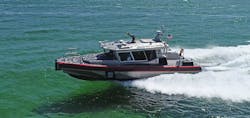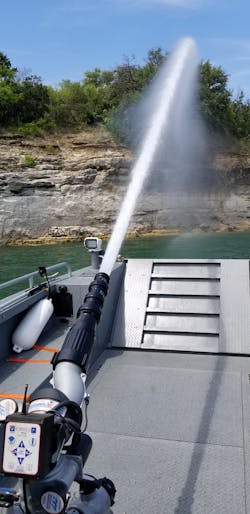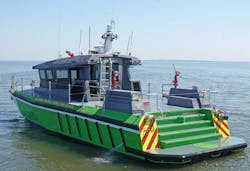When the public thinks about fireboats, they very well might envision floating behemoths that bristle with monitors and deliver thousands of gallons of water to blazing ships, warehouses and piers. Although such large vessels remain in service, they now are the exception rather than the rule.
For every oceanfront department, there are dozens of others that cover lakes and rivers and their shoreline.
“Departments should design a boat around what they do 90 percent of the time, and the remaining 10 percent should be accommodated as much as possible,” Bob Beck of Lake Assault Boats advises. “It’s better to have a boat that does its main mission really well and the secondary missions a little less than a boat that does nothing really well.”
Boxes for the apparatus committee to check off, Beck tells Firehouse Magazine, include area of responsibility, infrastructure within the area, crew capabilities, crew training levels, availability of other resources, complexity of the mission and what the department can support in its area of responsibility.
Thus, such purpose-built fire vessels often are smaller and faster than their predecessors were. Whether purpose-built fireboats act as platforms for rescue and recovery dive teams or as emergency medical transports or they engage in firefighting operations, their design bears little resemblance to once was the tradition. Today’s fireboats are capable of rapid maneuverability and operation under the most extreme conditions.Then and now
Where the first fireboat was put into operation is a matter of definition and local bragging rights. It seems clear that hand-powered pumps were placed afloat in the late 1700s and early 1800s.
Early iterations included upfitting tugboats with monitors and pumps. Although these were in keeping with the times, their capabilities were limited. In 1875, Philadelphia outfitted boats for firefighting, but, oddly enough, they were staffed by police officers. The Philadelphia Bureau of Fire placed the Edwin S. Stuart, a true fireboat, into service in 1893.
New York City might arguably have the most famous fleet in the United States, which has included the Fire Fighter, which now serves as a museum, and the Fire Fighter II, currently in service with its partner ship, the Three Forty Three. Although considerably smaller in size than their predecessors were, these vessels reflect concerns of today’s seagoing smoke eaters with the inclusion of filtration systems that protect their crews against chemical, biological, radiological and nuclear (CBRN) exposure.
Advances in conventional land-based suppression systems are seen in their water-based cousins—for example, advances in pump controls (moving to digital from analog) and incorporating additional agents. However, the improvements don’t stop there. Navigation/guidance, propulsion and steering systems have been upgraded significantly. Features such as waterline access stairs and patient transport compartments were quite the exception in the past.
Beyond water incidents
In its efforts to determine considerations that might be necessary to address during the specification process, Firehouse Magazine reached out to the Cape Coral, FL, Fire Department (CCFD) regarding its recent purchase.
Cape Coral has 400 miles of waterways. Residents and visitors spend significant time on inland waterways and southwest Florida’s Gulf beaches.
The CCFD has a marine team that consists of 66 members and three boats. In addition, all CCFD firefighters are rescue swimmers. Divers have advanced training and use dry suits and full-face mask communications, among other specialized equipment.
The department’s new boat’s official designation is Marine 9, but it will be named in honor of retired CCFD Battalion Chief Todd Rigoni, who was the driving force behind replacing old and impractical fireboats. The new boat was built by Silver Ships and has twin 350-hp motors.
“The unit is equipped with a fire pump for marine fires, holds emergency medical supplies for medical response, efficiently transports the CCFD dive team and their equipment [and contains] technology to assist with search and rescue operations,” CCFD’s Andrea Schuch explains.
This multiplatform design/construction exemplifies the paradigm shift away from single-purpose operation (fight fires).
Similar requirements can be seen on the West Coast, particularly in the case of a 28-foot craft that’s stationed in Needles, CA, that protects the Colorado River.
“We can directly fight fire or support ground-based operations, and it has comprehensive dive and rescue capabilities,” Brian Wells, who is an engineer with the San Bernardino County, CA, Fire Protection District, says. “It also is designed to serve as a wildland team personnel carrier and ATV transport.”
Still, the direct firefighting role remains important, particularly where terrain can restrict the operation of conventional apparatus.
“Homes today around Lake Tahoe are larger, built closer together and are located farther from the lake, while emergency access is hampered by narrow roads and limited turnarounds for responding fire trucks, and that makes this fireboat an important new tool in our firefighting arsenal,” Eric Guevin, who is the fire marshal for the Tahoe Douglas Fire Protection District in Zephyr Cove, NV, adds. In other words, the vessel’s functionality goes beyond addressing water incidents.Maneuverability
As firefighting needs change, it’s up to manufacturers to offer continually improved designs.
Lake Assault Boats’ Beck says that his company is reacting to demand for one-touch joystick engine controls and digital anchor controls as well as forward-looking infrared camera systems and crew communications systems.
Beck says that the Mercury Skyhook Digital Anchor system uses GPS technology and an electronic compass to automatically control shifting, throttling and steering, to help first responders to maintain heading and position. The Mercury Joystick Piloting system, he adds, can move a fireboat sideways or at an angle in any direction and can rotate a fireboat on its own axis, for safe maneuvering in close quarters via a push or twist of a single joystick.
Dean Jones of Metal Shark says, “In general, fireboats continue to adapt a more multi-role and prime first responder role, enhancing everyday safety but also security in some instances.”
Technology has allowed the integration of threat detection and suppression via Purple K (specific to liquefied natural gas terminals coming online), he explains.
He continues, “Fireboats are now being designed specifically to enhance rescue and EMS missions.” Vessels focus on EMS benches, equipment storage and capability and better ways to search for, find and extract a patient as well as to provide triage and to transfer the patient at the dock or via helicopter lift if needed.
Electric and amphibious
As with all vehicles, both civilian and firefighting, a push is on to reduce carbon emissions. Dutch shipbuilder Damen delivered two plug-in hybrid firefighting vessels to authorities in Hamburg, Germany. According to plugboats.com, which focuses on electric boats, the Dresden and the Prag, as the two vessels are dubbed, are billed as the world’s first electric firefighting boats. They can operate completely in electric mode. This feeds Lake Assault Boats’ Beck’s impression that electric propulsion is unfolding.
Although amphibious vehicles aren’t necessarily new to the fire service, a new generation that delivers greater capacities than their predecessors (primarily the DUKW, or Duck), has emerged. According to Jo Stapleton of Ocean Craft Marine, “It is important to remember that [Ducks] were military surplus and were primarily designed to drive straight ahead.”
This is in contrast to units that are manufactured by his firm, which is a division of Asis Boats, which specializes in what are known as rigid hull inflatables. This configuration provides a lightweight and easily maneuverable vessel that can be trailered to a launch site or driven directly into the water, depending on location.
According to Stapleton, his company’s four-wheel-drive hydraulic system can reduce deployment time “by seven to ten minutes” and can make launch and retrieval safer, improve handling and provide a top speed of 40–60 miles per hour.
On course
While we await even more upgrades to our floating firefighting arsenal, it’s obvious that innovation already has improved crew safety and functionality of craft. Modern vessels reflect the needs of today’s fire service and most certainly aren’t your grandfather’s fireboats.
About the Author

Barry Furey
BARRY FUREY, who is a Firehouse Contributing Editor, provides consulting and training services in emergency communications. He is the former director of the Raleigh-Wake Emergency Communications Center in North Carolina. During his 50-year public safety career, he has managed 9-1-1 centers and served as a volunteer fire officer in three other states. In 2005, Furey received a life membership in the Association of Public-Safety Communications Officials (APCO) International for his continued work in emergency communications. Furey was inducted into the Firehouse Hall of Fame in 2017.


